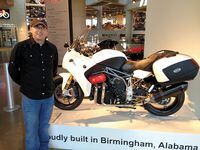Can you imagine anything crazier than setting out to build your own motorcycle today? And we’re not talking here some latter-day Rickman frame up or even pulling a Bimota—starting with an existing engine and building a unique bike to amaze your friends. And we are talking here about building for general consumption, not garage-cobbled “some-offs” sold to incautious riding buddies.
Starting fresh rarely happens, and there’s good reason for that: It’s extremely difficult.
Just ask Brian Case and Lee Conn, co-founders of Motus Motorcycles . The MST-1 has been visible since the first drawings left Case's hand in 2008, and, in 2011, very early machines were ridden and reported on as though the model was nearly ready to produce. In truth, the very first pair of Motuses (Moti?) were little more than proof-of-concept machines, hand-built with components never intended to be economical to produce.
Everything that had to be proven was done on these two, over the course of five-plus years, and then two pre-production examples were built. So the actual production version of the MST-1—just recently given EPA approval (see Up To Speed, Emissions-Legal Motus here)—was set to begin its slow ramp up in December 2014, with a goal of building 10 bikes before the end of the year. Ultimately, the plan is to build 300 a year.
None of this would have been possible without the clear-eyed resolve of Case and Conn, who started by asking what kind of bike they themselves wanted to own. “We’d all done sportbikes and cruisers,” Conn says. “We’re true enthusiasts here, but we also realized that there was some value in doing a genuinely American bike with great performance credentials. But it also had to be comfortable, and that drove us to the first ideas behind the MST-1.” Deconstruct this statement to see the wisdom of avoiding direct competition with the Europeans and the Japanese in the supersport realm. Only engineering budgets underwritten by myriad other product lines allow that kind of intensive, continued development.
In large part, the delay following the initial showing at Laguna Seca in 2011 and today’s quiet start of production can be blamed on the engine—but in a good way. While the 1,650cc V-4 shares parts with Chevy’s LS-1 V-8, they are fewer in number than you’d think. And in no way is this a small-block Chevy run through a massive bandsaw; it’s an engine developed specifically for this application. The reasoning behind starting with Chevy parts? Pretty simple, actually: So much is known about combustion-chamber design, valve train geometry, bearing sizes, and other factors that a fair portion of the engineering was, in essence, already done.
But there was still so much to do, and when I spent the better part of a week in Birmingham, Alabama, with Case and Conn and the Motus team of half a dozen, it became clear that a small amount of Stockholm syndrome was at work. Through all the late nights and lost weekends working through engineering challenges alongside development partner (and stakeholder) Pratt & Miller, through the days spent refining the shape of the machine in clay and steel tube, and through all the weeks finding suppliers who would support a small-scale effort (and building their own for the parts without a worthy source), the guys have put so much of themselves into the product that I don’t think even they see it.
Now, it’s all about pushing to the finish line, silencing the critics who have called the Motus “vaporware” (or worse), and making happy those “couple of hundred” depositors who bet on a small upstart. Having spent the day on a conforming, production-spec MST-1, I can say they’ll be delighted. Plus, Case and Conn might actually get to take a vacation. They deserve it.












/cloudfront-us-east-1.images.arcpublishing.com/octane/2WF3SCE3NFBQXLDNJM7KMXA45E.jpg)
/cloudfront-us-east-1.images.arcpublishing.com/octane/G4MG6OUCJNBSHIS2MVVOTPX65E.jpg)
/cloudfront-us-east-1.images.arcpublishing.com/octane/IIGGWFOTOJGB7DB6DGBXCCMTDY.jpg)
/cloudfront-us-east-1.images.arcpublishing.com/octane/QSTCM6AVEZA5JJBUXNIQ3DSOF4.jpg)
/cloudfront-us-east-1.images.arcpublishing.com/octane/U4I7G625B5DMLF2DVIJDFZVV6M.jpg)
/cloudfront-us-east-1.images.arcpublishing.com/octane/B6XD6LS6IVCQPIU6HXDJSM3FHY.jpg)
/cloudfront-us-east-1.images.arcpublishing.com/octane/ICL63FEDDRDTTMINYICCEYGMDA.jpg)
/cloudfront-us-east-1.images.arcpublishing.com/octane/FCGZHQXRBZFLBAPC5SDIQLVF4I.jpg)
/cloudfront-us-east-1.images.arcpublishing.com/octane/WNOB6LDOIFFHJKPSVIWDYUGOPM.jpg)

/cloudfront-us-east-1.images.arcpublishing.com/octane/X33NU3E525ECRHXLNUJN2FTRKI.jpg)
/cloudfront-us-east-1.images.arcpublishing.com/octane/6KKT5NNL2JAVBOXMZYS5ZO76YA.jpg)
/cloudfront-us-east-1.images.arcpublishing.com/octane/J5RKG5O455GMPGQRF2OG6LRT7A.jpg)
/cloudfront-us-east-1.images.arcpublishing.com/octane/GX2CIZKQVRH2TATDM26KFG2DAE.jpg)
/cloudfront-us-east-1.images.arcpublishing.com/octane/ZWIDYSAKQZHD5BHREMQILXJCGM.jpg)
/cloudfront-us-east-1.images.arcpublishing.com/octane/CYUHJZCTSJCH3MRAQEIKXK7SCQ.jpg)
/cloudfront-us-east-1.images.arcpublishing.com/octane/LKOFINY56FCXJCANJ5M7ZDQUBY.jpg)
/cloudfront-us-east-1.images.arcpublishing.com/octane/4NBPDACMWJH63JQYJVK3QRBDZI.jpg)
/cloudfront-us-east-1.images.arcpublishing.com/octane/KKHQHRR3FJGX7H2IPU6RALMWG4.jpg)

/cloudfront-us-east-1.images.arcpublishing.com/octane/5IOFS5JAE5FOXMNA23ZRAVVYUU.jpg)
/cloudfront-us-east-1.images.arcpublishing.com/octane/CGXQ3O2VVJF7PGTYR3QICTLDLM.jpg)

/cloudfront-us-east-1.images.arcpublishing.com/octane/OQVCJOABCFC5NBEF2KIGRCV3XA.jpg)